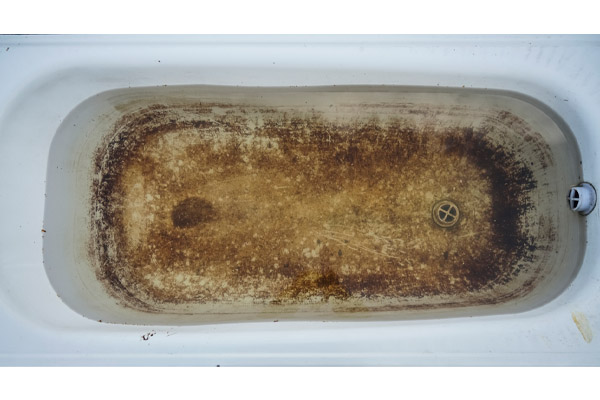Were you hunting for tips on Why is There Sewage Coming Up Through the Bathtub?

Sewer back-up in the bath tub can be an upsetting and unsanitary trouble for any type of home owner. Not only is it bothersome, however it additionally presents severe wellness risks and shows underlying problems with the plumbing system. Recognizing why sewage is turning up via the bathtub is crucial for taking proper action to address the trouble efficiently.
Introduction to the Problem
Understanding the Trouble
When sewage draws back up into the bathtub, it's a clear indication of a problem with the water drainage system. The wastewater that ought to be flowing far from your home is instead locating its back right into your space, which can bring about significant damages and health hazards.
Prospective Reasons
Several aspects can add to sewage backup in the bath tub. From clogs in the drain line to issues with the plumbing framework, identifying the source is essential for discovering a remedy.
Common Reasons for Sewage Backup
Obstructions in the Drain Line
One of one of the most common root causes of sewer backup is an obstruction in the sewer line. This can happen because of the buildup of debris, oil, or foreign objects in the pipes, stopping correct circulation and triggering sewer to back up right into your bath tub.
Tree Origin Intrusion
Tree origins looking for wetness and nutrients can infiltrate sewer lines with tiny fractures or joints. With time, these roots can expand and broaden, causing considerable damage to the pipelines and resulting in sewer back-up problems.
Aging Infrastructure
Older homes might have outdated plumbing systems that are a lot more at risk to corrosion, fractures, and degeneration. As pipes age, they become a lot more susceptible to leakages and obstructions, increasing the probability of sewage backup events.
Heavy Rainfall or Flooding
Throughout durations of heavy rainfall or flooding, the sewer system may come to be overloaded with excess water, creating back-ups and overflows. This can lead to sewer supporting right into tubs and various other fixtures inside the home.
Wellness Threats Associated with Sewer Back-up
Contamination of Water System
Sewage back-up can contaminate the supply of water in your house, positioning a major health risk to you and your family members. Exposure to contaminated water can lead to intestinal issues, skin infections, and various other diseases.
Spread of Disease
Sewer contains unsafe germs, viruses, and parasites that can create a series of conditions, including liver disease, cholera, and gastroenteritis. Entering contact with sewage or infected surface areas puts you in jeopardy of infection.
Mold and mildew Development
Dampness from sewage backup can produce excellent problems for mold and mildew growth in your house. Mold spores can exacerbate respiratory troubles and trigger allergic reactions in delicate people, making timely cleaning important.
Indications of Sewer Backup
Foul Odors
Unpleasant odors originating from drains or fixtures, especially in the shower room, may indicate sewage back-up concerns. These odors are usually strong and relentless, signifying an issue that requires prompt attention.
Slow Draining Fixtures
Bath tubs, sinks, and bathrooms that drain gradually or not at all could be experiencing sewage backup. If multiple components are impacted concurrently, it's likely that the issue stems from a common factor, such as the major drain line.
Gurgling Sounds
Strange gurgling or gurgling noises originating from drains when water is running somewhere else in your house are a measure of air entraped in the plumbing system. This air accumulation can result from sewer backup and ought to be examined immediately.
Immediate Actions to Take
Shutting Off Water Supply
In the event of sewage backup, it's vital to shut off the water system to prevent further contamination and damages. Situate the major water shutoff valve in your home and closed it off until the problem can be settled.
Getting In Touch With a Professional Plumber
Managing sewer back-up is not a do it yourself work. Contact a certified plumber with experience in handling sewage-related problems to analyze the circumstance and carry out necessary repair work or cleanings.
Staying Clear Of Contact with Infected Water
Until the sewage backup is settled, avoid contact with polluted water to stop the spread of bacteria and microorganisms. Put on protective equipment if you have to be in the affected location and clean your hands completely later.
Preventive Measures
Normal Maintenance of Drain Lines
Schedule normal evaluations and maintenance of your drain lines to recognize and attend to potential concerns prior to they intensify right into major troubles. This can include clearing out particles, checking for tree root invasion, and repairing any damaged pipes.
Setting Up Bayou Valves
Take into consideration mounting bayou shutoffs in your plumbing system to prevent sewage from flowing back into your home during periods of heavy rainfall or flooding. These valves immediately close when water starts backing up, securing your residential or commercial property from contamination.
Correct Disposal of Family Waste
Prevent flushing anything besides toilet tissue and human waste down the toilet to prevent blockages and clogs in the drain line. Dispose of oil, oil, and other household chemicals properly to reduce the risk of plumbing problems.
Cleaning Up After Sewer Back-up
Sanitation Procedures
Thoroughly sanitize and sterilize influenced areas after sewer backup to eliminate damaging germs and prevent mold and mildew growth. Usage appropriate cleaning products and protective gear to guarantee risk-free and reliable clean-up.
Restoration of Influenced Areas
Repair any damage to flooring, walls, or components brought on by sewer backup. Depending on the extent of the damage, you may need to replace carpets, drywall, or various other products to recover your home to its pre-loss condition.
Why Is Water Backing Up in My Bathtub When I Flush My Toilet?
What to do about a sewer line clog
First, don’t bother with plunging. No amount of plunging will dislodge the clog in a sewer line. The clog is too far away. Plungers are for clogs in the toilet itself, not the sewer line. Plus, the most likely causes of a sewer clog are:
Tree roots Flushed toys or feminine products Grease buildup Those items don’t move easily. And in the case of tree roots, the roots need to be cut out of the pipe and the pipe will need to be repaired.
You’ll need a closet auger. A closet auger is a type of plumber’s snake with a protective cover to keep from scratching the delicate porcelain toilet. If the clog is further down, you may need to remove the toilet or use one of your cleanouts to get to the clog.
We also recommend doing a video inspection of the drain to ensure that the cause of the clog has been completely removed. Otherwise, you could have the same problem again in a few days or weeks.
https://mspplumbingheatingair.com/blog/why-is-water-backing-up-in-my-bathtub-when-i-flush-my-toilet

As a passionate reader about Why sewage is coming up through your bathtub, I thought sharing that information was essential. If you enjoyed our blog posting if you please don't forget to share it. I recognize the value of your readership.
Call Today